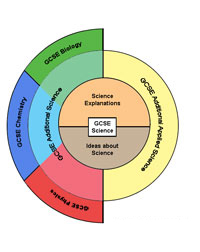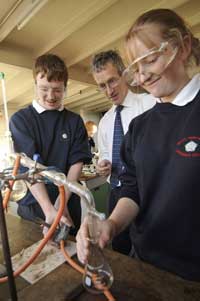Twenty First Century Science: developing a new science curriculum Inspire article
In September 2006, after a pilot phase, a new national curriculum for science was introduced for students aged 14-16 in England and Wales. Jenifer Burden explains how the new curriculum seeks to address both the scientific needs of all citizens, and the additional needs of future scientists.

provides a comprehensive
coverage of how science
works. Click to enlarge image
Students in England and Wales follow a compulsory national curriculum to the age of 16. This curriculum includes the study of science, incorporating key ideas from biology, chemistry, and physics. From September 2006, the science curriculum for students aged 14-16 has changed significantly.
All students now follow a core course, regardless of their future progression in science, with an emphasis on developing scientific literacy. This is in contrast to the previous national curriculum for this age group, which was determined by the perceived needs of students who would progress to further academic study. In the new scheme, most students also follow an additional science course, discussed further below.
Both the well-documented decline in student uptake of science following compulsory education, and the negative trend in students’ attitude to the science curriculumw1, contributed to a drive to revise the national curriculum. The influential report, Beyond 2000 (Millar & Osborne, 1998), led to the development of a pilot model for a new approach to the curriculum. Known as Twenty First Century Science, this model was commissioned by the Qualifications and Curriculum Authority (QCA)w2, the government body responsible for regulating the school curriculum in England and Wales. A small team based at the University of York Science Education Group and the Nuffield Curriculum Centre developed the pilot curriculum and supporting teaching resources, which were trialled in more than 75 schools from September 2003. Following a review of the pilot, QCA developed a new national curriculum for England and Wales based on the Twenty First Century Science model. It is important to note, however, that not all students follow Twenty First Century Science – this is one of several interpretations of the national curriculum which teachers may select.
How did Beyond 2000 influence the new curriculum?
A key recommendation from Beyond 2000 is that compulsory science education should focus on scientific literacy. This is science education which can be justified as relevant for any student, regardless of their future aspirations. This recommendation prompted several questions during the early development of Twenty First Century Science, such as:
- What does ‘scientific literacy’ mean?
- What might constitute a school science course for scientific literacy?
- How can we, at the same time, educate our future scientists?
We might describe a scientifically literate person as someone who:
- Appreciates what science has to tell us about ourselves, the Earth and Universe;
- Recognises the impact of science and technology on everyday life;
- Takes informed personal decisions about things that involve science, such as health, air quality and use of energy resources;
- Understands the essential points of media reports on science-based issues, and reflects critically on the information in, or crucially omitted from, such reports;
- Takes part confidently in discussions with others about issues involving science.
At the heart of Twenty First Century Science is a core course followed by all students, known as GCSE Science, which develops knowledge and skills relevant to the above aims.
What makes up GCSE Science?
Clearly it is impossible to engage with science at all without understanding some science content. The GCSE Science course therefore includes key ‘science explanations’ – the major stories of scientific knowledge (see box below). A course to develop scientific literacy should emphasise these big explanations, rather than a lot of disconnected detail, which is unnecessary at this level and indeed may discourage many students from pursuing further scientific study.
Science explanations
- Chemicals
- Chemical change
- Materials and their properties
- The interdependence of living things
- The chemical cycles of life
- Cells as the basic units of living things
- Maintenance of life
- The gene theory of inheritance
- The theory of evolution by natural selection
- The germ theory of disease
- Energy sources and use
- Radiation
- Radioactivity
- The Earth
- The Solar System
- The Universe
The second, equally important, element of scientific literacy is an understanding of the nature of science and its social context, referred to in the GCSE Science course as ‘ideas about science’ (see box below). These are the ideas necessary to engage with science in everyday life, but they are also key ideas needed by any future scientist. For example, an understanding of the distinction between correlation and cause is as useful to a citizen reading a newspaper article about the findings of an epidemiological study as it is to the scientist who designed the study. Both will also need an understanding of the limitations of data to judge its reliability. A new scientific claim may involve controversy, so all of us need some understanding of how scientists develop explanations, and the ability to identify evidence and construct argument, together with a working knowledge of the scientific community and peer-review system. Both a citizen making a personal decision, and a scientist putting forward recommendations for social policy will draw on an understanding of risk and the frameworks within which decisions based on science and technology are made.
Clearly, practising scientists will engage with ideas about science more deeply than the scientifically literate layperson, but at the level of GCSE Science, students gain an understanding of these ideas that will be relevant to them regardless of their future ambitions.
Ideas about science
- Data and its limitations
- Correlation and cause
- Developing explanations
- The scientific community
- Risk
- Making decisions about science and technology
GCSE Science is taught through a series of modules which provide engaging contexts for students. Although the contexts are useful, it is above all the ideas about science and science explanations – key concepts of science and how it works – that the GCSE Science course aims to instil in students. This understanding is essential for all citizens, not only those who go on to be scientists.
What about future scientists?

North Yorkshire, studying the
key science explanation of
chemical change.
Image courtesy of Twenty First
Century Science
The great majority of students following the Twenty First Century Science curriculum also study one or more additional courses, to satisfy their innate curiosity about the material world, and in some cases because they are interested in a science-based career. Since the key skills of scientific literacy are developed in GCSE Science, a variety of additional courses have been developed, allowing students to select those which best meet their particular needs.
GCSE Additional Science is designed for students who wish to follow a more academic route in science. Students explore a number of science explanations in more detail, encountering more abstract concepts and scientific models than in GCSE Science. Some students may choose to devote an even greater proportion of their time to sciences, and study for separate qualifications in GCSE Biology, GCSE Chemistry, and/or GCSE Physics.
Alternatively, in GCSE Additional Applied Science, students extend their understanding of particular science explanations, but in work-related contexts, which emphasise the role of technical practitioners in fields such as health care, agriculture, and communications.
Course assessment
Clearly a revised curriculum cannot make any real impact on practice unless an appropriate assessment system is devised, consistent with the aims of each course. In Twenty First Century Science the most innovative development of assessment is found in the GCSE Science course. Designing tools to assess students’ scientific literacy is a challenge, and work is ongoing. Nonetheless, significant progress was made during the pilot. Further information regarding assessment can be found on the project websitew3.
How effective is the new curriculum?
Such a major change in the curriculum requires significant investment, not least by teachers who must implement new courses in their schools. Strong motivation is required to undertake such a change.
As the new national curriculum was introduced into schools across England and Wales only in September 2006, it is much too early to assess the large-scale effects. Nonetheless, feedback from the teachers involved in the Twenty First Century Science pilot study since 2003 has been very positive (see box below). An independent evaluation of the pilot has been conducted, and further information will be added to the project website as it becomes available.
Teacher feedback
“The philosophy is sound, and works in practice. The support materials are excellent, and assessment varied and stimulating, definitely not a set of arbitrary hoops to be jumped through. […] No student has asked me since we started why they need to do science, or to know something we’ve covered. Our GCSE grades have improved, and we have detected no problems with transition to science A-levels [ages 16-18]. Twenty First Century Science has been the best thing to happen to my science teaching since I started in 1989. We’ve embraced the change, and haven’t regretted it for a moment.”
“The parents tell us that their kids are coming home and talking enthusiastically about what they’ve been doing in science.”
“The courses give young people the opportunity to think for themselves and attain informed views and opinions.”
Note from the editor
We would be interested to hear about experimental new curricula elsewhere in Europe. Has a radically different curriculum been introduced in your country? How well did it work? What did the teachers and students think about it? What difficulties were faced in the introductory phase, and how were these overcome? We would be particularly interested in teachers’ views of the new curricula.
References
- Millar R, Osborne J (1998) Beyond 2000: Science Education for the Future. London, UK: King’s College
- The report can be downloaded from the King’s College London website.
Web References
- w1 – For information about the ROSE study of students’ attitudes to science, see:
- Sjøberg S, Schreiner C (2006) How do students perceive science and technology? Science in School 1: 66-69.
- and the ROSE study website.
- w2 – Qualifications and Curriculum Authority (QCA)
- w3 – Twenty First Century Science website
Review
This article makes interesting reading for science policy-makers and teachers furthering their studies at university. The article is relevant outside the UK, for those who seek to enrich their knowledge of the current debate in foreign countries. Although its main interest is for policy-makers, it is useful for school science teachers who want to keep abreast of innovation and the justifications for change.
The article summarises the main features of the new curriculum and gives justification for its introduction in England and Wales. Some of the salient points mentioned, such as the definition of a scientific literate person and what might constitute an appropriate syllabus for such a person, may create a discussion amongst science teachers about what should and should not be taught in the science class.
The introduction of a new science curriculum is never an easy task. However, as Jenifer Burden mentions, the decline in the student uptake of science and the negative trend in students’ attitude to the science curriculum compel those responsible to do something. The dilemma of how to offer a science curriculum which caters adequately for both future scientists and other citizens has been debated for the last few years in my country. In a recent meeting of the association of science teachers in Malta, it was stated that such a reform in secondary-school curricula needs to be complemented with a similar reform in primary-school and post-secondary-school science. This point was not mentioned in Burden’s article, but she gives details of a rethinking of the assessment policy to accompany the reform, which seems to be supported by teachers in the UK. The reform seems to have the right ingredients to be conducted successfully.
Gaetano Bugeja, Malta





